Stoffwindeln waschen - Wissen komplett
- Stoffwindeln richtig waschen - Das komplette Wissen
- Die Waschregeln - kurz und knapp
- Wenn du mehr über das Waschen wissen willst
- Was landet in der Windel, wovon sie wieder gereinigt werden muss?
- Wie funktioniert die Waschmaschine?
- Das richtige Waschprogramm auswählen
- Das Waschmittel - Wirksamkeit, Dosierung, Auswahl
- Weitere Tipps zum Waschen und Trocknen
- Pflegesymbole zum Waschen und Trocknen
- Wenn du alles über das Waschen wissen möchtest
- Verbreitete Annahmen über das Windelnwaschen
- Fehlerbehebung - Troubleshooting
- Quellen
Stoffwindeln richtig waschen - Das komplette Wissen
(Lesezeit 30 Minuten)
Der größte Unterschied zur Einwegwindel ist schlichtweg, dass die Stoffwindel gewaschen wird. Logisch. Für viele stehen hinter dem Waschen deswegen die größten Fragezeichen. Wir zeigen dir mit einfachen Mitteln auf, wie deine Windeln am besten sauber und gepflegt bleiben.
Willst du alles über Windelwäsche wissen? Dann lies einfach weiter. Du findest auf unseren Seiten wirklich jedes Detailwissen zum Waschen und Trocknen. Auf unseren anderen Seiten findest du alles über das Lagern von benutzten Windeln und das Waschen und Pflegen von Wolle.
Die Waschregeln - kurz und knapp
Es gibt vier Grundregeln, die du beachten solltest, damit deine Stoffwindeln sauber werden und intakt bleiben. Für alle Windeln, die mit Urin oder Stuhl in Kontakt gekommen sind, gilt die folgende Waschroutine:
- Gebrauchte Windeln so, wie sie sind, für maximal drei Tage in trockener Umgebung lagern. Bitte nicht in Wasser oder mit Wasser getränkten Stoffen!
- Vorwäsche oder Feinspülen inklusive Abpumpen wählen.
- Koch- und Buntwäscheprogramm oder Baumwollprogramm bei 60 °C, wenn möglich mit Wasserplus wählen; mäßig schleudern (800-1.000 Umdrehungen). Bitte kein Öko- oder Sparprogramm wählen!
- Vollwaschmittel Pulver verwenden, da Sauerstoffbleiche darin schon enthalten ist. An die Wasserhärte anpassen und bei Bedarf Enthärter zugeben und für weiches Wasser dosieren.
- Zügig trocknen (wenn trocknergeeignet: Schontrocknen).
Innenwindeln kannst du ausnahmsweise und nur bei leichten Verschmutzungen auch mal mit deiner normalen Kleidung bei 30-40 °C waschen. Ein Wäschenetz ist dabei empfehlenswert, es schützt die PUL-Stoffe vor mechanischen Verletzungen.
Wollprodukte dürfen nicht in die normale Wäsche. Diese wäschst du im Wollprogramm oder per Hand mit Wollwaschmittel oder milder Seife.
Ganz genaue Waschempfehlungen für unsere WindelManufaktur Produkte findest du in einer übersichtlichen Tabelle in unserer Gebrauchsanleitung mit allem, was wichtig ist.
Waschmittel: Unsere Einlagen sind äußerst langlebig. Deswegen fällt es uns besonders auf, wenn wir von Kund*innen Rückmeldungen über einen frühzeitigen Verschleiß bekommen. Dieser scheint durch Waschmittel mit dem Inhaltsstoff Aloe Vera begünstigt zu werden.
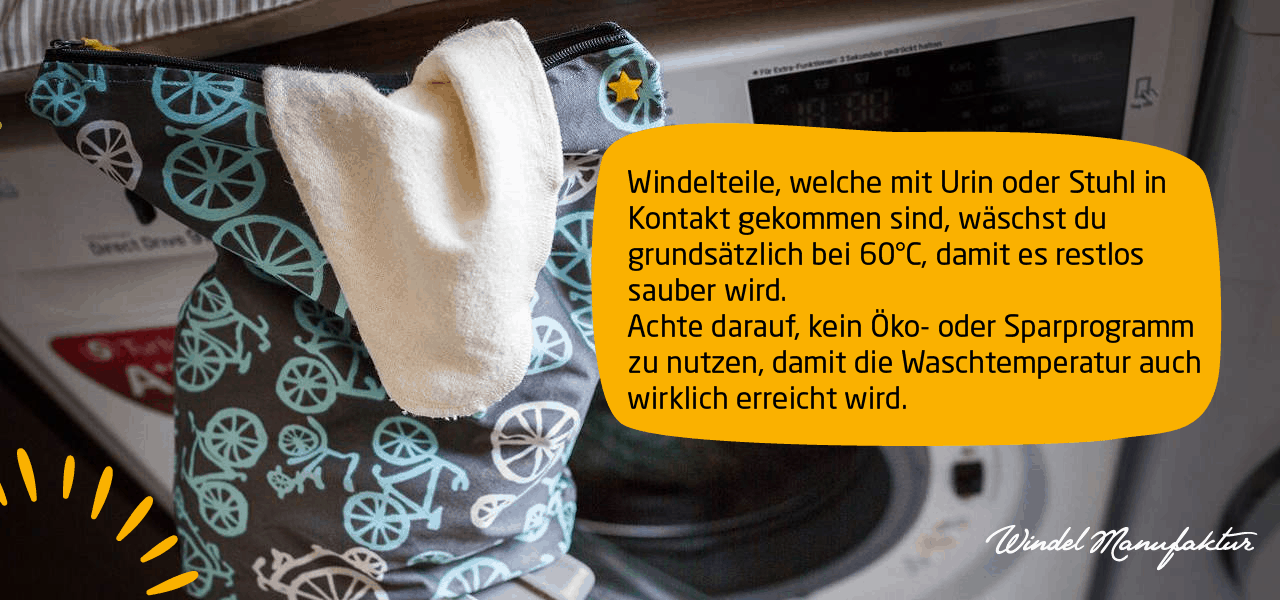
Wenn du mehr über das Waschen wissen willst
Du hast schon so viel Widersprüchliches im Internet gelesen und bist nun verunsichert? Du liebst es, die Dinge umfassend zu verstehen?
Waschen ist ein ganz spannendes Wissensfeld. Dabei gibt es unheimlich viele Aspekte, die beim Waschen zusammenkommen, so dass man schnell den Überblick verliert. Wir haben für dich bis ins Detail recherchiert, wie du
- sauber,
- sparsam und
- umweltfreundlich wäschst.
Dabei berufen wir uns ausschließlich auf gesicherte Quellen. Wir laden dich herzlich ein, dich darauf einzulassen.
Um das Waschen zu verstehen, benötigst du zuerst etwas Hintergrundwissen. Hierzu möchten wir die folgenden drei Fragen klären:
- Was landet in der Windel, wovon sie wieder gereinigt werden muss?
- Wie funktioniert die Waschmaschine?
- Welche Inhaltsstoffe im Waschmittel sind waschwirksam?
Wenn du die Antworten auf diese drei Fragen verstehst, kannst du nicht nur deine Stoffwindeln perfekt waschen, sondern auch jedes andere Kleidungsstück.
Was landet in der Windel, wovon sie wieder gereinigt werden muss?
Weißt du eigentlich, was in der Windel landet? Klar, denkst du jetzt. Aber was genau ist das, wovon die Windel gereinigt werden muss?
Urin
Urin besteht hauptsächlich aus Wasser, Harnstoff und Salzen. Er ist leicht sauer.
Stuhl
Stuhl besteht hauptsächlich aus Ballaststoffen, Unverdautem wie Fetten, Stärke, Gewebsfasern und Proteinen. Außerdem ist im Stuhl der Farbstoff Bilirubin enthalten. Dieser verursacht die Flecken in den Windeln. Das heißt, auch fleckige Windeln können trotzdem sauber sein und verwendet werden.
Hautpflegemittel
Zusätzlich zu den Ausscheidungen kommen eventuell noch Hautpflegemittel, die mit der Windel in Kontakt gekommen sind. Meistens sind es Cremes, in denen Fette, Öle und vielleicht auch Zinkoxid enthalten sind.
Wie funktioniert die Waschmaschine?
Wusstest du, dass es eine Waschformel gibt? Diese nennt sich „Sinnerscher Kreis“ [1] und hat sich schon seit ungefähr 60 Jahren bewährt. Sie beschreibt den Einfluss von vier Faktoren auf das Reinigungsergebnis:
- Mechanik der Waschmaschine (das Drehen der Wäschetrommel und das Aneinanderreiben der Wäsche)
- Chemie (das Waschmittel)
- Temperatur
- Zeit (die Einwirkzeit)

Hinzu kommt noch Wasser, durch das die vier Faktoren erst wirksam werden. Alle Faktoren wirken bei der Wäschereinigung zusammen. Änderst du einen dieser Parameter, kannst du ihn durch Veränderung eines anderen ausgleichen. Damit erzielst du das gleiche Waschergebnis. Das Bundesministerium für Wirtschaft und Energie (BMWi) hat hierzu ein wunderbar anschauliches Video veröffentlicht:
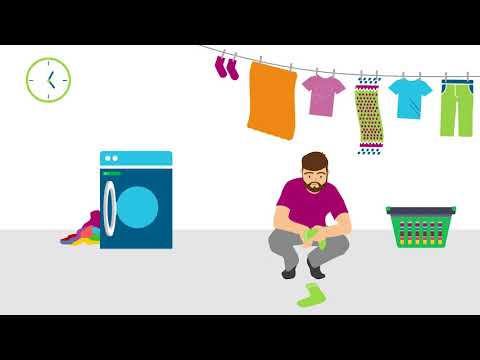
Das bedeutet: Wäschst du bei niedrigen Temperaturen, muss die Maschine länger laufen, damit die Wäsche sauber wird. Mit diesem Prinzip werden Waschprogramme konzipiert. Wenn du also ein 60°C-Eco-Programm hast, wird es nicht bei 60°C waschen, sondern die Waschzeit verlängern, um die Temperatur auszugleichen. Dadurch werden Energie und Kosten gespart. Beim Waschen von Saugeinlagen solltest du trotzdem auf Energiesparprogramme verzichten, da die Waschtemperatur von 60°C für die hygienische Reinigung von Stoffwindeln wichtig ist.
Das richtige Waschprogramm auswählen
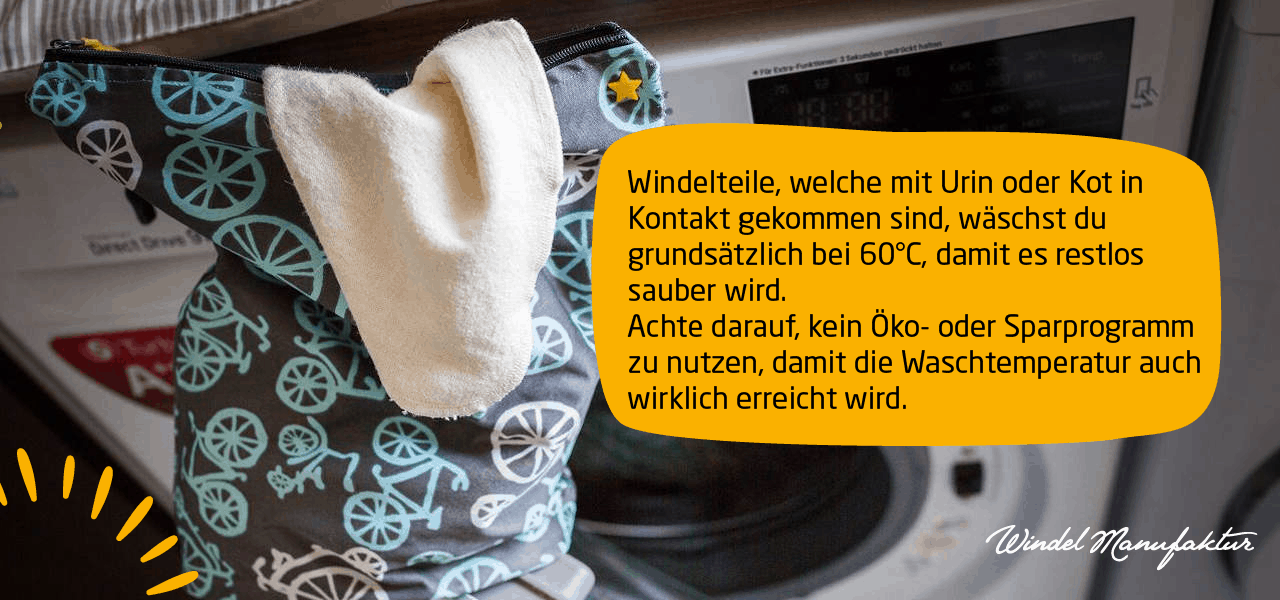
Vorwaschen
Wir empfehlen, vor dem Hauptwaschprogramm eine Vorwäsche zu schalten. Wichtig ist, dass das Wasser nach der Vorwäsche abgepumpt wird. Wenn dein Vorwaschprogramm dies nicht tut, kannst du auch ein Feinspülprogramm wählen. Die Vorwäsche hat mehrere Vorteile:
- Der Urin wird bereits größtenteils ausgespült.
- Eventuelle Stuhlreste werden ausgespült.
- Die Stofffasern werden eingeweicht und entspannen sich. Dadurch kann sich der Schmutz auf den Fasern leichter lösen.
Achte darauf, dass das Waschmittel im Vorwaschprogramm noch nicht zum Einsatz kommt.
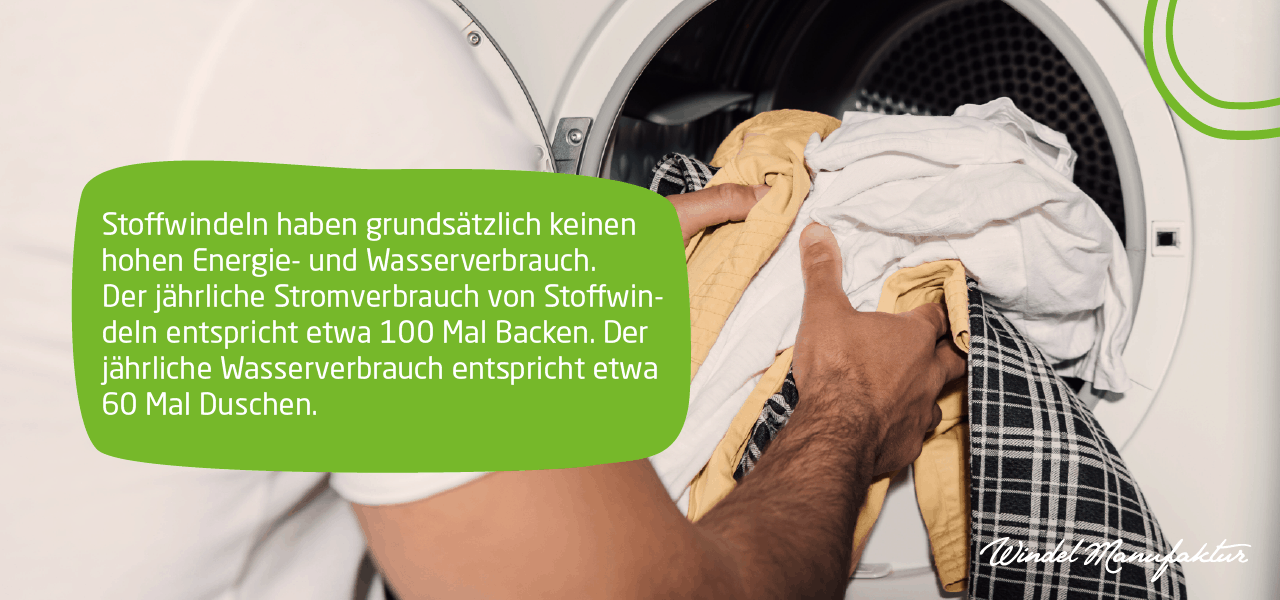
Koch- und Buntwäscheprogramm
Saugeinlagen solltest du im Baumwoll- oder Kochwäscheprogramm waschen. Dieses nutzt die ideale Kombination aus Temperatur, Zeit und Mechanik. Besonders mehrlagiges Saugmaterial muss gut durchgewalkt werden. Dies ist in anderen Programmen nicht immer gewährleistet.
Die Maschine füllst du nicht zu voll (am besten sollte noch eine Handbreit Platz sein), damit die Windeln genug Bewegung bekommen. Bitte beachte hier die Herstellerangaben für die maximale Zuladung.
Waschtemperatur
Saugmaterial, welches mit Urin oder Stuhl in Kontakt gekommen ist, wäschst du grundsätzlich bei 60°C, damit es restlos sauber wird.
Hochwertiges PUL, also Innenwindeln, Überhosen und Wetbags, kannst du regelmäßig im gleichen Programm waschen. Sie können aber auch zur 30-40°C Buntwäsche hinzugefügt werden.
Bei dreiteiligen Systemen (Ai3) kannst du die Außenteile immer mit der Buntwäsche zusammen waschen.
Handwäsche
Manche besonders empfindliche Materialen erfordern eine Handwäsche, dazu gehören Wolle und Seide. Das passende Zeichen am Waschetikett ist
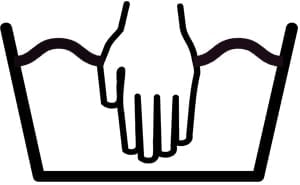
Bei der Handwäsche wird bei maximal 40°C, mit viel Wasser und möglichst wenig Mechanik mit einem sanften Waschmittel per Hand gewaschen und anschließend mit viel Wasser ausgespült. Waschmaschinen verfügen über Programme, die eine Handwäsche nachstellen können. Dabei dreht die Trommel nicht komplett. Sie wiegt die Wäsche vorsichtig hin und her.
Bei Windeln kommen größtenteils Wollprodukte mit dieser Waschkategorie zum Einsatz. Tipps und Tricks hierzu findest du auf unserer Ratgeberseite zur Wollpflege.
Schleudern
Die Umdrehung fürs Schleudern der Windelwäsche reduzierst du auf 1.000 Umdrehungen. So sparst du Energie und verminderst Abnutzung. Die Einlagen bekommen trotzdem genügend Bewegung, um anschließend zügig zu trocknen.
Wolle schleuderst du auf der geringsten verfügbaren Schleuderzahl (meistens 800 Umdrehungen), da sie sonst verdichten kann. Einige Wollprodukte vertragen auch höhere Schleuderzahlen gut. Beachte bitte dazu die Angaben der Hersteller.
Energie- und Wasserverbrauch
Viele scheuen sich vor dem Gebrauch von Stoffwindeln, da sie einen hohen Energie- und Wasserverbrauch beim Waschen befürchten. Sie wissen aber nicht genau, wie hoch der Verbrauch überhaupt ist. Hier ist ein Rechenbeispiel:
Nehmen wir an, du wickelst dein Kind über 3 Jahre und wäschst deine Windeln separat alle drei Tage die Woche. Du hast eine moderne Durchschnittsmaschine, deren Abnutzung wir aus dem Kaufpreis und einer Lebensdauer von 10 Jahren, beziehungsweise 1.840 Waschzyklen berechnen. Du verwendest ein herkömmliches Waschmittel aus der Drogerie, welches normal dosiert wird. In der Übersicht siehst du zum einen den Verbrauch von Strom und Wasser sowie die Kosten, die sich daraus ergeben.
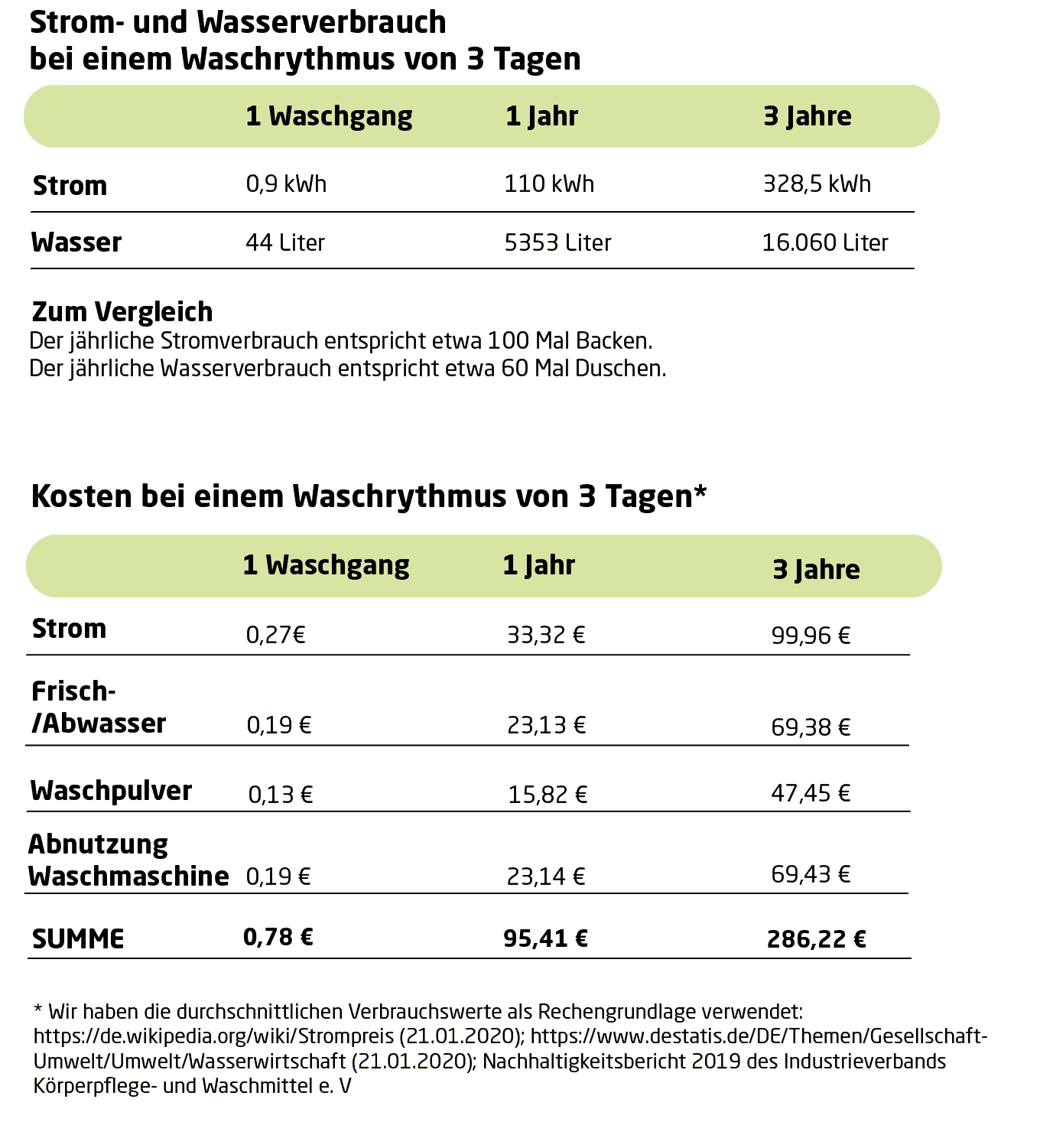
Damit du die Zahlen in ein Verhältnis zum Gesamtverbrauch setzen kannst:
- Der durchschnittliche Energieverbrauch eines 3-Personen-Haushaltes liegt bei 4.200 kWh pro Jahr [2].
- Beim Wasserverbrauch sind es ca. 123 l pro Person und Tag [3], das heißt 134.685 l pro Jahr.
Das Stoffwindelnwaschen macht also lediglich 4-5 % des gesamten Verbrauchs aus. Selbst ein sparsamer Trockner würde hier noch weniger zu Buche schlagen als zum Beispiel Heizkosten. Durch die Anzahl der Windeln kannst du die gesamte Waschhäufigkeit reduzieren. Bei getrennten Windelteilen kannst du Vieles mit deiner normalen Buntwäsche zusammen waschen. Ein dreiteiliges System ist dabei am vorteilhaftesten.
Für deine eigene Waschmaschine kannst du dir das ganz leicht mit der Tabelle aus unserem Artikel zum Kostenvergleich Stoffwindeln vs. Wegwerfwindeln ausrechnen.
Auf unserer Seite zur Ökobilanz kannst du dich ausführlich über den Vergleich von Stoffwindeln und Wegwerfwindeln informieren.

Das Waschmittel - Wirksamkeit, Dosierung, Auswahl
Das Waschmittel hat drei Hauptaufgaben.
- Es löst den Schmutz aus den Fasern (waschaktive Substanzen und Enzyme).
- Es verhindert, dass die gelösten Stoffe sich noch während des Waschvorgangs wieder auf den Fasern absetzen (Inhibitoren).
- Es verhindert, dass sich Salze aus dem Waschwasser auf den Fasern absetzen (Enthärter).
Zusätzlich sind oftmals weitere Inhaltsstoffe enthalten:
- Wasserschäumung regulieren: Seifen und Silikone
- pH-Wert erhöhen, damit Fasern aufquellen und sich Schmutz besser löst: Waschalkalien
- Flecken behandeln: Sauerstoffbleichmittel
- Weißes weißer machen: optische Aufheller
- Fasern glätten: Enzym Cellulase
- Wäsche duften lassen: Duftstoffe
- Waschmittel rieselfähig und haltbar machen: Stellmittel/Konservierungsstoffe
Du willst noch genauer wissen, welche Inhaltsstoffe in Pulver- und Flüssigwaschmitteln enthalten sind? Dann scroll weiter runter in den nächsten Abschnitt mit allen Detailinfos über Waschmittel.
Wie das Waschmittel bei Stoffwindeln wirkt
In dieser Tabelle haben wir aufgelistet, welche Stoffe aus den Windeln mithilfe des Waschmittels entfernt werden können:
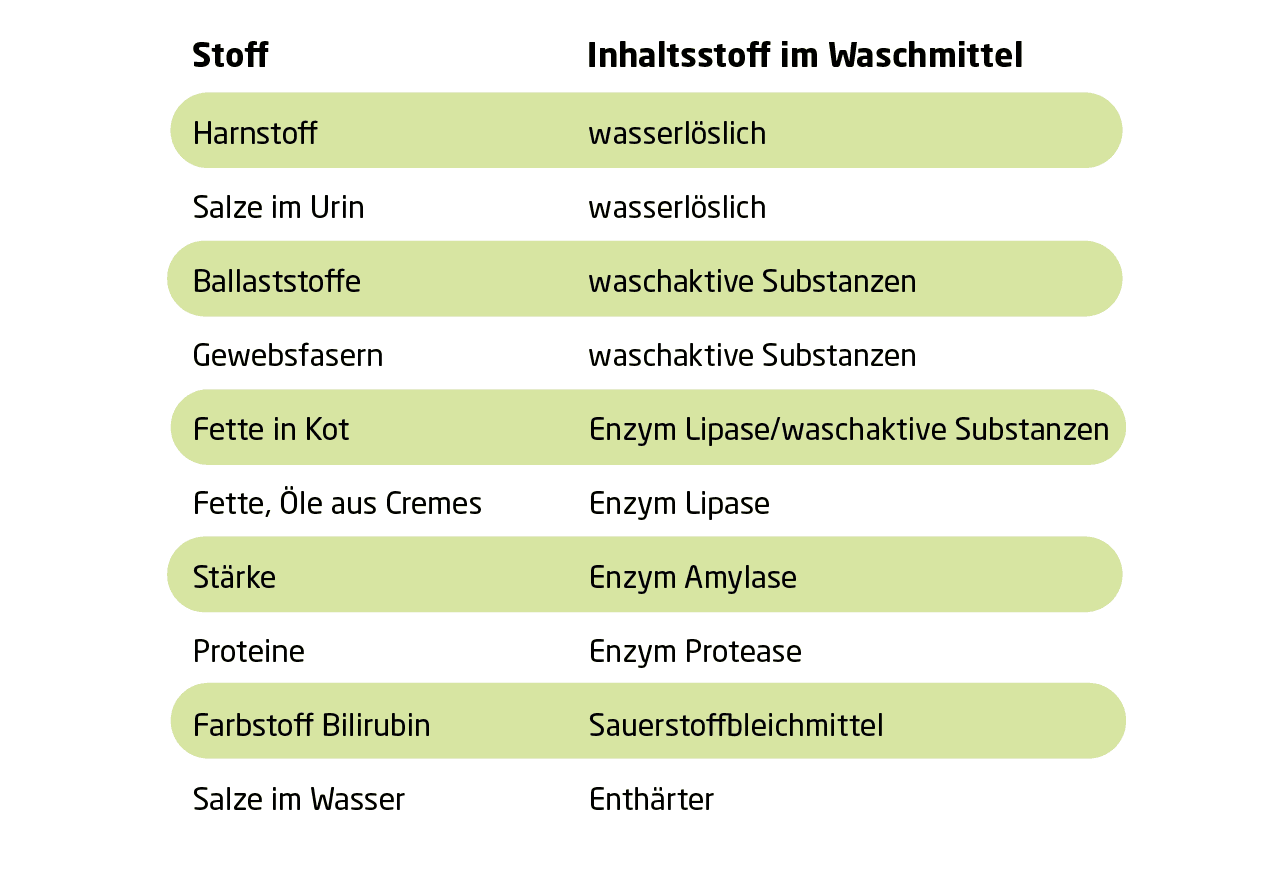
Diese Inhaltsstoffe sind in der Regel in einem Pulvervollwaschmittel vorhanden. Das darin enthaltene Sauerstoffbleichmittel wirkt zusätzlich desinfizierend.
Auf die richtige Dosierung kommt es an
Wichtig ist, dass du auf die Dosierung achtest und den Empfehlungen des Waschmittelherstellers folgst. Die Dosierung richtet sich immer nach der Wasserhärte. Denn die waschaktiven Substanzen können nur wirken, wenn die Salze aus dem Waschwasser nicht im Weg sind. Je härter das Wasser ist, desto mehr Wasserenthärter wird benötigt. Die Wasserhärte kannst du bei deinem Versorgungsunternehmen erfragen.

Für weiches Wasser benötigst du keinen Enthärter zusätzlich zum Vollwaschmittel, da dieser ausreichend darin enthalten ist. Ab mittel-hartem Wasser empfehlen wir, zusätzlich Enthärter zum Waschmittel hinzuzugeben. Du dosierst dann für weiches Wasser und sparst dadurch am Waschmittel. Die waschaktiven Substanzen wirken nämlich schon in der niedrigen Dosierung.
Bei sehr hartem Wasser kannst du auch noch flüssigen Entkalker (z. B. auf Milchsäure-Basis) ins Weichspülfach geben. Dieser entkalkt das Spülwasser, welches nach dem Waschvorgang neu eingespült wird. So läufst du nicht Gefahr, dass sich erneut Salze auf den frisch gewaschenen Windeln absetzen. Ein weiterer positiver Effekt: Sie werden dadurch weicher.
Beim Windelnwaschen ist die Beachtung der Wasserhärte besonders wichtig. Zu wenig Enthärter führt früher oder später zu „Stinkewindeln“. Die Salze des Waschwassers verbinden sich mit der Seife des Waschmittels und lagern sich als Kalkseife auf den Fasern ab. Zusätzlich binden sich Keime und andere Rückstände daran. Diese riechen besonders stark im erneuten Kontakt mit Urin.
Waschmittelauswahl – konventionell oder öko?
Im Handel erhältst du konventionelles Waschmittel und Öko-Waschmittel.
Öko- oder Bio-Waschmittel enthalten
- pflanzliche oder mineralische Inhaltsstoffe
- natürliche Duftstoffe aus ätherischen Ölen
- recyceltes oder recyclebares Verpackungsmaterial
und vermeiden im Gegensatz zu vielen konventionellen Waschmitteln
- Inhaltsstoffe auf Erdölbasis oder tierischen Ursprungs (oder an Tieren getestete Inhaltsstoffe)
- gentechnisch hergestellte Enzyme
- Zusatzstoffe
- umweltbelastende Stoffe wie Mikroplastik
Oft werden Öko-Waschmittel nach dem Baukastenprinzip angeboten. So stellst du das Waschmittel passgenau zur Wäsche zusammen. Prüfe immer die Angaben des Herstellers, da der Begriff Öko-Waschmittel oder Bio-Waschmittel nicht geschützt ist.
Konventionelle Waschmittel waschen Windeln zuverlässig sauber. Bestimmte Zusatzstoffe solltest du möglichst vermeiden: EDTA (Ethylendiamintetraacetat), Phthalate, Triclosan oder synthetische Duftstoffe. Diese sind schwer abbaubar. Mehr Informationen zum Thema Duftstoffe im Waschmittel findest du beim Umweltbundesamt.
Waschmittel aus gesundheitlichen Gründen auswählen
Folgende Inhaltsstoffe werden bei Neurodermitis oder Asthma möglicherweise schlecht vertragen oder können Allergien auslösen:
- synthetische Duftstoffe
- optische Aufheller
- synthetische Tenside
- Bleichmittel auf Chlorbasis
- Konservierungsstoffe
- ätherische Öle
Deswegen solltest du besonders darauf achten, wenn die Haut deines Kindes empfindlich reagiert.
Waschmittel der Umwelt zuliebe auswählen
Waschmittel belastet grundsätzlich Kläranlagen und Gewässer [4]. Du kannst mit der Beachtung der Inhaltsstoffe und der Herstellungsmethoden aber wesentlich beeinflussen, wie stark du damit die Umwelt belastest. Umweltfreundliche Waschmittel erkennst du z. B. an dem Ecolabel, der sogenannten Euroblume oder dem Blauen Engel. Außerdem lohnt sich immer ein Blick auf die Inhaltsstoffe.

Fleckenbehandlung mit der Kraft der Sonne
Flecken musst du nicht unbedingt behandeln. Sie sind kein Anzeichen für ungenügende Reinigungsleistung. Meistens verschwinden sie bei einer 60°C Wäsche von selbst. Stuhlflecken, auch vom Muttermilchstuhl, enthalten Bilirubin. Dieses zersetzt sich im Sonnenlicht. Zur Fleckenbehandlung legst du den feuchten Stoff am besten mehrere Stunden in die Sonne. Das klappt auch ohne direkte Sonneneinstrahlung, was vorteilhaft bei PUL und Wolle ist. Wollhaare bzw. die Beschichtung werden sonst durch starke Hitze auf Dauer spröde.
Alle anderen Flecken kannst du mit (veganer) Fleckenseife bzw. Gallseife oder biologisch unbedenklichem Fleckenspray behandeln. Flecken auf Wolle kannst du oft mit einem feuchten Lappen entfernen. Auch das Einweichen in kaltem Wasser mit Olivenkernseife löst Flecken zuverlässig aus Wolle.
Mit 60 °C hygienisch rein
Viele Waschgewohnheiten von früher sind längst überholt. Dank moderner Waschmaschinen und Waschmittel ist Waschen heutzutage so einfach wie noch nie. Für Stoffwindeln gilt: Statt wie früher bei 90°C, reichen heute 60°C vollkommen aus. Lediglich, wenn dein Baby einen ansteckenden Infekt oder Soor hat(te), gibst du einen EL Sauerstoffbleiche zusätzlich zum Vollwaschmittel. Dieses reicht in Kombination mit 60°C aus für eine desinfizierende Wäsche. [6]
Ein Hygienespüler ist unnötig, belastet die Umwelt und löst möglicherweise allergische Reaktionen aus. Zum Desinfizieren kannst du ebenso gut umweltfreundliche Sauerstoffbleiche verwenden.
Fleckenbehandlung mit der Kraft der Sonne
Flecken musst du nicht unbedingt behandeln. Sie sind kein Anzeichen für ungenügende Reinigungsleistung. Meistens verschwinden sie bei einer 60°C Wäsche von selbst. Stuhlflecken, auch vom Muttermilchstuhl, enthalten Bilirubin. Dieses zersetzt sich im Sonnenlicht. Zur Fleckenbehandlung legst du den feuchten Stoff am besten mehrere Stunden in die Sonne. Das klappt auch ohne direkte Sonneneinstrahlung, was vorteilhaft bei PUL und Wolle ist. Wollhaare bzw. die Beschichtung werden sonst durch starke Hitze auf Dauer spröde.
Alle anderen Flecken kannst du mit (veganer) Fleckenseife bzw. Gallseife oder biologisch unbedenklichem Fleckenspray behandeln. Flecken auf Wolle kannst du oft mit einem feuchten Lappen entfernen. Auch das Einweichen in kaltem Wasser mit Olivenkernseife löst Flecken zuverlässig aus Wolle.
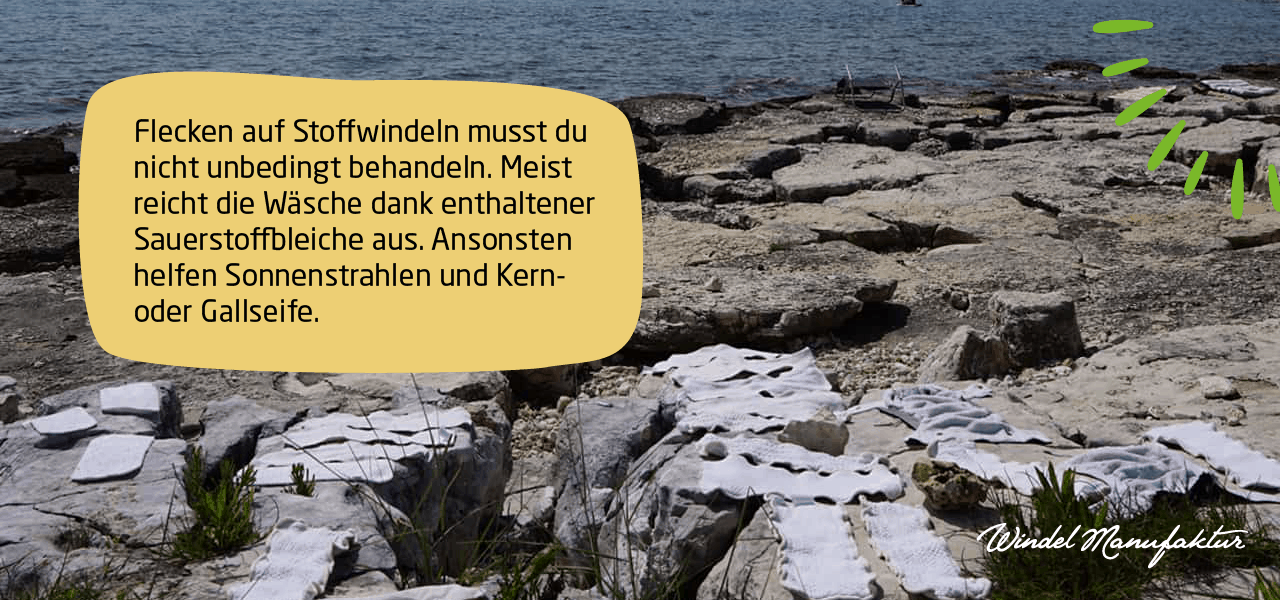
Mit 60 °C hygienisch rein
Viele Waschgewohnheiten von früher sind längst überholt. Dank moderner Waschmaschinen und Waschmittel ist Waschen heutzutage so einfach wie noch nie. Für Stoffwindeln gilt: Statt wie früher bei 90°C, reichen heute 60°C vollkommen aus. Lediglich, wenn dein Baby einen ansteckenden Infekt oder Soor hat(te), gibst du einen EL Sauerstoffbleiche zusätzlich zum Vollwaschmittel. Dieses reicht in Kombination mit 60°C aus für eine desinfizierende Wäsche. [6]
Ein Hygienespüler ist unnötig, belastet die Umwelt und löst möglicherweise allergische Reaktionen aus. Zum Desinfizieren kannst du ebenso gut umweltfreundliche Sauerstoffbleiche verwenden.
Textilien, die mir Urin und Stuhl in Kontakt kommen, sollten regelmäßig bei 60°C gewaschen werden. Manchmal "meint man es gut" und möchte die Sachen lieber nur bei 40°C waschen - aber in diesem Fall ist das kontraproduktiv. Die Produkte halten länger und du hast länger Freude daran wenn sie hygienisch sauber werden.
Weitere Tipps zum Waschen und Trocknen
Einwaschen: Damit das Saugmaterial wirklich gut saugt
Vor der ersten Benutzung solltest du alle Produkte mindestens einmal bei mind. 30°C in der Waschmaschine waschen, um Rückstände von der Produktion zu entfernen.
Damit das Saugmaterial seine volle Saugkraft entfaltet, wäschst du es vor der Benutzung mehrmals ein. Hierfür kannst du es z. B. auch zusammen mit deiner Buntwäsche bei 30°C waschen. Saugmaterial geht beim Waschen etwas ein. Wichtig ist, dass es nach dem Waschen jeweils komplett durchtrocknet. Du kannst die Windel auch schon nach der ersten Wäsche verwenden. Rechne aber damit, dass sie noch nicht ihre volle Saugleistung erreicht hat und schneller gewechselt werden muss.
Windeln unterwegs waschen
Wenn du auf Reisen keine Waschmaschine zur Verfügung hast, gibt es auch andere Möglichkeiten, die Windeln wieder sauber zu bekommen. Wir haben dir in unserem Blogartikel zu Stoffwindeln im Urlaub ein paar Tipps zusammengestellt.
Die richtige Waschmaschinenpflege
Viele Eltern beschäftigen sich erst durch das Waschen der Stoffwindeln intensiver mit ihrer Waschmaschine. Wie du weißt, kann die Maschine auch bei niedrigen Temperaturen sauber waschen. Möglicherweise bildet sich dadurch aber in Verbindung mit Kalkseife ein Biofilm oder sogar Kalkablagerungen auf den Leitungen. Deswegen solltest du die Waschmaschine regelmäßig reinigen. Dafür empfehlen wir Folgendes:
- Einmal im Monat ein 90°C-Programm ohne Wäsche und Waschmittel durchlaufen lassen, ggf. mit speziellem Waschmaschinenreiniger.
- Gummidichtungen regelmäßig auswischen (Essig vermeiden – es macht Gummis spröde!).
- Spülfach und Flusensieb regelmäßig reinigen.
- Grundsätzlich bei jeder Wäsche Enthärter der Wasserhärte entsprechend verwenden.
Bitte beachte immer die Pflegehinweise des Herstellers.
Im Trockner oder auf der Leine trocknen
Das optimale Trocknen der Stoffwindeln nach dem Waschen richtet sich nach Material und Pflegesymbol. PUL und Wolle sind dabei besonders empfindlich, Baumwolle ist eher robust.
Wichtig ist, dass die Windelwäsche und besonders das Saugmaterial nach dem Trocknen keine Restfeuchte enthalten, die zu Bakterienbelastung führen kann.
Saugmaterial kann in den Trockner, der Rest auf die Leine
Grundsätzlich belastet eine Trocknung im Trockner sowohl Fasern als auch Umwelt. Stoffwindeln verschleißen im Trockner wesentlich schneller als leinengetrocknet. Wenn du die Einzelteile trennen kannst, trockne die beschichteten und nichtsaugenden Stoffe (PUL, TENCEL™ Lyocell, Liner) am besten auf der Leine. Andernfalls prüfe die Pflegehinweise des Herstellers, ob die Windel in den Trockner darf.
Saugmaterial kannst du im Trockner im Schontrocknen-Programm trocknen. Besser ist es, wenn du es lediglich im Trockner antrocknest und dann auf die Leine hängst. So wird der Stoff weich und die Fasern geschont.
Wolle sollte nicht in den Trockner, da sie bei Temperaturschwankungen und Bewegung verfilzt.
Was beim Leinentrocknen von Stoffwindeln zu beachten ist
Beim Trocken auf der Leine wird die Windelwäsche eher hart. Das tut ihrer Funktion keinen Abbruch und die meisten Kinder stört es auch nicht. Wenn du die Wäsche weicher bevorzugst, kannst du sie einmal durchkneten oder über eine Kante ziehen.
Grundsätzlich macht Wind beim Leinentrocknen die Wäsche etwas weicher und die Sonne bleicht Flecken aus. Dazu trocknen gerade Mullwindeln und andere dünne Einlagen sehr schnell draußen, weshalb sich das Leinentrocknen wirklich lohnt.
Bei beschichteten Stoffen und Wolle sind direkte, lange Sonneneinstrahlung (Hitzegefahr) und Trocknen auf dem Heizkörper (Spröde) tabu.
Wollprodukte legst du zum Trocknen z. B. auf einem Handtuch hin, damit sie ihre Form behalten.
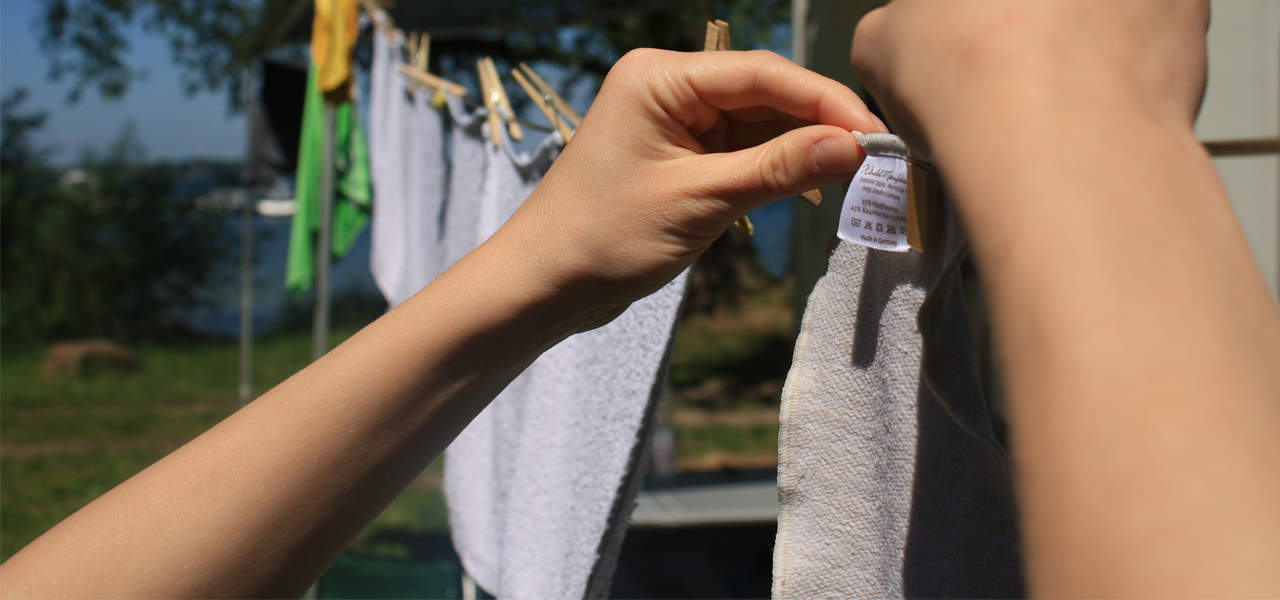
Pflegesymbole zum Waschen und Trocknen
Die Pflegesymbole zum Reinigen von Kleidung werden international genutzt. Es handelt sich dabei um die Hinweise zur Waschtemperatur, Trocknung und Pflege von Textilien, die eingehalten werden sollen. Für unsere Produkte sind die folgenden Symbole von Bedeutung:
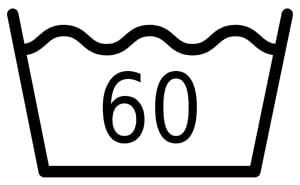
Waschen bei 60 °C
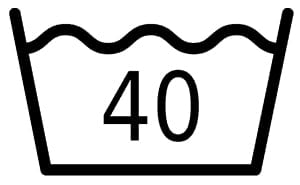
Waschen bei 40 °C
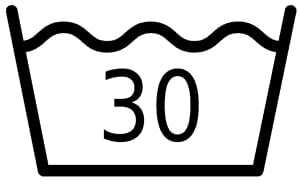
Waschen bei 30 °C

Handwäsche

Trommeltrocknen niedrige Temperatur (schonend)

Nicht im Trommeltrockner trocknen

Nicht bügeln

Nicht chemisch reinigen
Wenn du alles über das Waschen wissen möchtest
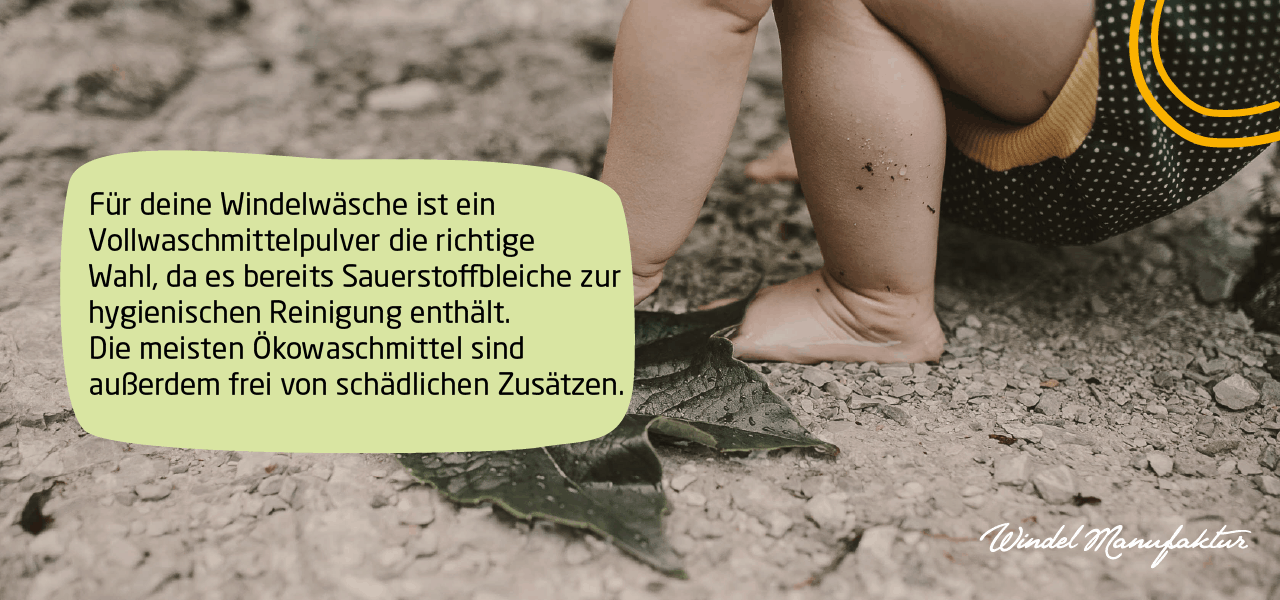
Welche Sorten von Waschmittel gibt es?
- Vollwaschmittel (auch Universalwaschmittel oder Kochwaschmittel genannt) sind für alle Temperaturbereiche (20°C bis 95°C), die meisten Textilien und Waschverfahren geeignet. Sie enthalten Bleiche und sind somit besonders für weiße Wäsche geeignet.
- Buntwaschmittel (auch Colorwaschmittel genannt) sind für bunte Textilien und Waschtemperaturen von 20°C bis 60°C
- Feinwaschmittel sind für die Waschtemperatur von 30°C und für die Maschinenwäsche und Handwäsche von empfindlichen Materialien. Sie enthalten keine Bleichmittel und optische Aufheller, dafür aber verstärkt Enzyme und Seife. Höhere Temperaturen zerstören die enthaltenen Enzyme.
- Spezialwaschmittel für Wolle, Seide, Daunen, Sport- und Membrantextilien oder Windeln sind in der Regel für niedrige Temperaturen geeignet.
- Baukastenwaschmittel bestehen aus den einzelnen Komponenten eines Vollwaschmittels, die individuell dosiert werden können. Diese Komponenten sind Enthärter, der angepasst an die Wasserhärte dosiert werden kann, Waschtenside und Sauerstoffbleiche. Die Hersteller Sodasan, Sonett, Klar und passt! bieten ein solches System an. Diese Form von Waschmittel eignet sich, wenn du hartes Wasser hast und somit einzelne Teile wie den Enthärter individuell dosieren möchtest. Je nach Verschmutzungsgrad kannst du das Grundwaschmittel und die Bleiche dosieren.
Was ist in Waschmittel enthalten?
- Tenside sind der waschaktive Hauptbestandteil von Waschmitteln. Sie lösen den Schmutz von Textilien ab oder verhindern die Wiedereinlagerung auf der Textilfaser und machen, je nach Waschmittel, einen Anteil von rund 20 bis 30%. Sie sorgen dafür, dass sich nicht mischbare Stoffe wie Öl und Wasser fein vermischen lassen und helfen so beim Abtransport von Schmutz. Moderne Vollwaschmittel enthalten oft eine Kombination von mehreren Tensiden, beispielsweise eine Kombination von LAS und FAEO, sowie ein geringer Anteil Seife. Die meisten anionischen Tenside werden leider aus Erdöl gewonnen, da sie sehr effektiv sind, mittlerweile setzen viele Hersteller aber auch auf nichtionische Zuckertenside aus nachwachsenden Rohstoffen. Bei Waschbär findest du zum Beispiel noch mehr Infos zu Tensiden.
- Wasserenthärter erzeugen weiches Wasser, indem sie kalkhaltiges Wasser neutralisieren. Zwar bilden sich bei heutigen Tensiden ohnehin meist keine Kalkseifen mehr, allerdings schädigen die beim Trocknen entstehenden Calcium- und Magnesiumsalze die Textilstrukturen. Wasserenthärter verhindern Kalkablagerungen in der Waschmaschine und verbessern die Tensid-Eigenschaften. Mineralische Enthärter in Pulverform wie Zeolith A, Schichtsilikate und Citrat sowie Soda sind die gängigsten Inhaltsstoffe. Hier gibt es mehr Infos zum Thema Wasserenthärter.
- Waschalkalien können verschiedene Chemikalien beinhalten, wie Natriumcarbonat, und erhöhen den pH-Wert der Waschlauge. Damit quellen die Fasern auf und der Schmutz lässt sich leichter ablösen.
- Enzyme können in geringen Mengen in Waschmittel enthalten sein und spalten Schmutzstoffe B. für die Entfernung von Eiweiß-, Stärke- und fetthaltigen Flecken. Sie sind meist von genmanipulierten Mikroorganismen hergestellt, Verdauungsenzyme aus Tierorganen werden nur noch in Gallseife (gibt es auch als vegane Version) verwendet. Das Enzym Amylase ist zum Abbau von Stärke geeignet und entfernt so zum Beispiel Kakao aus Textilien. Protease baut Eiweiße ab, entfernt also auch Blutflecken. Lipase baut Fette wie Butter und Öl ab, greift aber Wolle und Seide an. Cellulase entfernt kleine Fasern durch den Abbau von Cellulose und macht die Textilien glatter und weicher. Dieses Enzym kann zum höheren Verschleiß von Pflanzenfasern basierten Textilien wie Bambusviskose und TENCEL™ Lyocell führen.
- Kernseifen und Silikone regulieren die Schaumentwicklung als Entschäumer. Sie vermeiden den übermäßigen Wasserverbrauch, um Schaum zu zerstören und auszuspülen. Denn dieser hat bei der Wäsche keine Funktion, auch wenn viele Verbraucher Schaum mit Sauberkeit verbinden.
- Duftstoffe überdecken den Eigengeruch des Trägers der Kleidung. Es gibt synthetische und natürliche Duftstoffe in Form von ätherischen Ölen. Über die Wirkung ist noch nicht allzu viel bekannt, einige Duftstoffe können aber Kontaktallergien und Unverträglichkeiten auslösen. Deswegen solltest du zur Wäsche von Windeln und Babykleidung eher neutrale Waschmittel nutzen. Synthetische Duftstoffe können außerdem schwer abgebaut werden und landen oft in Gewässern.
- Stellmittel, wie Natriumsulfat, halten pulverförmige Waschmittel während der Lagerung pulverförmig und dienen als kostengünstiges Streckmittel. Waschmittel mit der Bezeichnung Konzentrat enthalten weniger Streckmittel. Die Wirkstoffe sind also weniger verdünnt und man spart Verpackungsmaterial.
Zusätzlich können noch folgende Stoffe enthalten sein:
- Bleichmittel entfernen nicht auswaschbare, farbige Verschmutzungen, z. B. von Früchten oder Blut. Achte darauf, unbedenkliche und umweltverträgliche Sauerstoffbleiche zu verwenden. Früher wurde Chlorbleiche verwendet, welche auf Grund der Umweltschädlichkeit zunehmend ersetzt wurde. Hier gibt es Infos zum Thema Bleichmittel.
- Bleichaktivatoren wie TAED erhöhen die Wirksamkeit der Bleichmittel bei niedrigen Temperaturen. Sie aktivieren durch eine chemische Reaktion die Bleichmittel schon ab 40°C.
- Optische Aufheller sind fluoreszierende Stoffe, die unter der Wirkung von Ultraviolettstrahlung, also zum Beispiel draußen, Weißes weißer erscheinen lassen. Bei farbigen Textilien kann sich durch die Aufheller der Farbeindruck verändern. Während sich ein Teil der Substanz an die Faser haftet, wird ein Teil ausgespült und gelangt in Abwasser und Gewässer. Es wird auch eine hormonelle Wirkung auf den Körper vermutet, die durch den Hautkontakt entsteht, deshalb sollte man beim Waschmittel auf optische Aufheller verzichten.
- Bleichstabilisatoren verhindern den unkontrollierten Zerfall der Bleichmittel während der Lagerung und beim Einsatz des Waschmittels.
- Konservierungsmittel sind bei pulverförmigen Waschmitteln nicht nötig, da mikrobakterieller Befall wegen Wassermangels kaum vorkommt. In flüssigem Waschmittel sind sie enthalten, um die Haltbarkeit zu erhöhen und Tenside zu lösen. Schwer abbaubare Stoffe, synthetische Konservierungsmittel belasten die Umwelt, indem sie in Gewässer gelangen und sich in der Umwelt anreichern. Ökowaschmittel enthalten natürliche Konservierungsmittel in Form von Milchsäure, Zitronensäure und Alkohol, welche biologisch abbaubar
- Alkohole verstärken reinigungswirksame Substanzen und ermöglichen bei flüssigen Waschmitteln, dass die Tenside gelöst werden können. Sie wirken teilweise auch als Konservierungsmittel.
- Wasserenthärter, welche in dem flüssigen Waschmittel löslich sind.
Wie alle diese Inhaltsstoffe genau wirken, kannst du auf den Seiten von Seilnacht nachlesen. Mehr zum Thema Inhaltsstoffe von Reinigungsmitteln findest du beim Umweltbundesamt.
Welches Waschmittel sollte ich benutzen?
Die einzelnen Komponenten von Waschmittel zum Windelnwaschen sind Grundwaschmittel, Enthärter und Sauerstoffbleiche.
- Vollwaschmittel ist ein Konzentrat, welches alle Komponenten vordosiert enthält. Daher empfehlen wir grundsätzlich die Verwendung von Pulvervollwaschmittel, denn es spart Verpackungsmüll und Konservierungsstoffe und wäscht durch die Inhaltsstoffe Windeln hygienisch sauber. Bei hartem Wasser solltest du zusätzlich Enthärter benutzen und das Waschmittel entsprechend der Dosierung für weiches Wasser dosieren.
- Eine weitere Option zum Stoffwindeln waschen ist das Baukastensystem in Pulverform, für diejenigen, die sich etwas mehr mit der Materie “Waschen” beschäftigen. Hier seien besonders die Passt! Waschkampagne, das Sonett Baukastensystem und das Sodasan Baukastensystem (Sensitiv Waschmittel, Enthärter und Sauerstoffbleiche) zu erwähnen. Die einzelnen Komponenten Grundwaschmittel, Enthärter und Sauerstoffbleiche können je nach Bedarf kombiniert Dabei solltest du die Wasserhärte und den Verschmutzungsgrad beachten.
- Eine weitere Möglichkeit ist, extra auf die Windelwäsche abgestimmte Produkte, also Windelwaschmittel zu verwenden. Notwendig ist es nicht. Es gibt Windelvollwaschmittel, welche du ohne Zusätze verwenden kannst. Außerdem gibt es noch Waschzusätze speziell für die Windelwäsche, welche durch Bleichaktivatoren bei allen Temperaturen für eine gute Reinigung sorgen. Dabei solltest du jedoch auf die Umweltverträglichkeit achten, also darauf, dass die Produkte biologisch abbaubar
- Sollte die Verwendung von Pulverwaschmittel nicht möglich sein, empfehlen wir folgende Lösung:
Bei flüssigem Waschmittel kannst du für hartes Wasser Enthärter in Form von Milchsäure dazu geben und das Waschmittel entsprechend der Empfehlung für weiches Wasser dosieren, denn die Waschleistung wird dadurch erhöht. Außerdem dient die Milchsäure als Weichspüler und sorgt für weiche Einlagen auch ohne Trocknerbenutzung. Bei weichem Wasser ist dies nicht nötig. Gelegentlich solltest du aber eine Kur mit Sauerstoffbleiche machen, damit sich Flecken lösen und die Einlagen desinfiziert werden.
Hier noch ein paar Tipps zum Waschen, damit deine Stoffwindeln richtig sauber werden:
- Sauerstoffbleiche solltest du regelmäßig zur Windelwäsche geben, denn sie wirkt desinfizierend und bleicht zusätzlich Flecken aus. Dies betrifft Saugeinlagen und andere Windelkomponenten, die mit Stuhl und Urin in Berührung kommen.
- Willst du weiche Windeln bzw. Saugeinlagen nutzen, solltest du ab und zu eine Kur mit Milchsäure machen oder die Windeln im Trockner antrocknen. Kurzes Durchkneten der luftgetrockneten Wäsche macht sie auch weicher.
Was ist Enthärter und wozu nützt er?
Wenn du bei kalkhaltigem Wasser und Waschmittel auf Seifenbasis wäschst, können Kalkseifen entstehen, welche sich in den Fasern anlagern können. Um dies zu verhindern, solltest du ab einer Wasserhärte ab 8,4 °dH Enthärter zur Wäsche geben.
Enthärter besteht meist aus Silikaten und erhöht die Waschleistung von Waschmittel, indem es kalkhaltiges, also hartes Wasser, neutralisiert. Dazu wird zum Beispiel Zeolith A, ein unlösliches Silikat, mit anderen, löslichen Silikaten kombiniert. Gerade beim Einsatz von Zeolith A kommt es aber bei Überdosierung zu Ablagerungen und Stinkewindeln. Deshalb solltest du den Enthärter angepasst an die Wasserhärte dosieren. Infos zur Wasserhärte in deinem Wohnort erhältst du bei deinem Wasserversorger.
In Vollwaschmittel ist Enthärter bereits enthalten, doch bei hartem Wasser werden bei höherer Dosierung andere Bestandteile des Waschmittels überdosiert, weshalb es sich hier anbietet, den Enthärter individuell anzupassen. Am besten dosierst du das Waschmittel entsprechend von weichem Wasser und gibst genug Enthärter zur Wäsche, damit das Wasser auch weich, also der Kalk neutralisiert ist. So sparst du Waschmittel und belastest das Wasser nicht unnötig mit Seife und anderen Komponenten.
Mineralischer Enthärter sorgt zwar für saubere Wäsche, kann aber nur mit Pulverwaschmittel kombiniert werden und macht die Wäsche nicht weich.
Für flüssige Waschmittel empfehlen wir deshalb Milchsäure als Enthärter. Sie macht die Wäsche weicher als mineralischer Enthärter und ist biologisch abbaubar.
Was ist hartes Wasser?
Bei hartem Wasser besteht die Gefahr, Inhaltsstoffe über oder unter zu dosieren, was zu übelriechenden Windeln oder Materialbeschädigungen führen kann. Daher spielt der Enthärter eine große Rolle. Wenn kalkhaltiges, also hartes Wasser, nicht neutralisiert wird, vermindert sich die Waschleistung. Es bilden sich Kalkseifen, welche die Materialien beschädigen und zu stinkenden Windeln durch Bakterienbefall führen.
Bei hartem Wasser solltest du deshalb Enthärter benutzen. Vermeide dabei Zeolith A als Inhaltsstoff. Sodasan verwendet zum Beispiel nur die löslichen Silikate „Sodium Carbonate“ und „Sodium Silicate“. Andere Hersteller benutzen Waschsoda (Soda) oder Citrate als Enthärter.
In allen Fällen solltest du darauf achten, dass der Enthärter biologisch unbedenklich ist. Das ist in der Form von flüssiger Milchsäure von Ulrich Natürlich und in Pulverform von Sodasan gegeben.
Wichtig: Flüssiger Enthärter wirkt nicht zusammen mit Pulverwaschmittel und Sauerstoffbleiche funktioniert nicht mit Flüssigwaschmittel.
Von reiner Zitronensäure in Pulverform solltest du Abstand nehmen, denn sie wirkt als Entkalker in der Maschinenreinigung, für die Wäsche ist sie zu aggressiv.
Ein paar weitere Tipps des Umweltamtes zum Thema umweltfreundlich waschen:
- Keine XXL-Packungen kaufen, da diese oft zu viele Füllstoffe enthalten.
- Hochkonzentrate sind umweltfreundlicher und enthalten weniger eingesetzte Chemie. Sie empfehlen bei normaler Verschmutzung pro Waschgang maximal 70 g Waschmittel.
- Keine Hygienewaschmittel verwenden, da diese Biozide enthalten.
- Auf Weichspüler lieber verzichten, weil sie viele Konservierungs- und Duftstoffe enthalten.
- Flüssiges Waschmittel beinhaltet mehr Konservierungsstoffe, daher öfter zu Pulver greifen.
- Generell lieber wenige Produkte verwenden. Vollkommen ausreichend sind laut Umweltbundesamt ein kompaktes Voll-, Color- und Feinwaschmittel. Jedes weitere Produkt bedeutet mehr Chemie und außerdem eine höhere Umweltbelastung durch Verpackungen oder den Transport.
Wie kann ich bei besonders hartem Wasser Waschmittel sparen?
Bei hartem Wasser, ab 8,4 dH solltest du dich mit Enthärtern beschäftigen. Zusätzlich zum Pulvervollwaschmittel solltest du Enthärter geben und dann die Dosierung entsprechend der Herstellerangaben reduzieren: Dosiere das Vollwaschmittel für weiches Wasser und gebe Enthärter in Pulverform dazu.
Auch mit dem Baukastensystem kannst du Waschmittel sparen, indem du die einzelnen Komponenten des Waschmittels angepasst an die Wasserhärte und den Verschmutzungsgrad dosierst. Dabei solltest du die Sauerstoffbleiche nicht vergessen. Wie beim Vollwaschmittel, neutralisierst du hartes Wasser durch den Enthärter und dosierst das Grundwaschmittel dementsprechend.
Unsere Empfehlung ist es, generell Pulverwaschmittel zu benutzen, da es Ressourcen spart. Sollte dies nicht möglich sein, kannst du auch Flüssigwaschmittel verwenden. Eine Möglichkeit, bei hartem Wasser Waschmittel zu sparen, ist die Kombination von Flüssigwaschmittel mit Enthärter in Form von Milchsäure. Du kannst so die Dosierung des Waschmittels so auf die Herstellerempfehlung für weiches Wasser reduzieren und die Wäsche wird außerdem etwas weicher.
Wie dosiere ich das Waschmittel korrekt?
Wie viel Waschmittel du brauchst, hängt in erster Linie von folgenden drei Faktoren ab:
- Der Wasserhärte,
- der Wäschemenge
- und dem Verschmutzungsgrad – wobei bei Windeln grundsätzlich von einem starken/hohen Verschmutzungsgrad auszugehen ist.
Ob die Dosierung korrekt ist, ist auf den ersten Blick oft nicht erkennbar, denn Windeln können trotz Fehldosierung optisch sauber erscheinen. Starke Gerüche und Hautirritationen im Windelbereich sind ein Anzeichen dafür, dass die Waschroutine deiner Windeln nicht optimal ist.
Warum ist die Dosierung des Waschmittels so wichtig?
Die richtige Dosierung des Waschmittels sorgt dafür, dass die Windeln hygienisch reingewaschen werden. Dabei solltest du die Umweltbelastung durch nicht abbaubare Waschmittelbestandteile und Überdosierung des Waschmittels vermeiden.
Sowohl eine Überdosierung als auch eine Unterdosierung des Waschmittels sorgen für Probleme bei der Windelwäsche. Denn so bilden sich oft Ablagerungen wie Kalkseifen oder Seife- und Pulverreste, welche die Saugfähigkeit von Einlagen vermindern. Außerdem können sich so Bakterien einnisten, die Windeln fangen an zu stinken und verursachen Hautirritationen. Dann benötigen sie eine Tiefreinigung.
Was muss ich beim Dosieren beachten?
Sowohl Über- als auch Unterdosierung schaden langfristig den Windeln und sind auf den ersten Blick nicht erkennbar.
Grundsätzlich empfehlen wir, den Herstellerempfehlungen zu folgen.
Es bietet sich aber an, 20-30% Waschmittel einzusparen, wenn du zusätzlich Enthärter oder Sauerstoffbleiche verwendest, welche die Reinigungsleistung erhöhen. Wenn du sicherstellen willst, dass die Waschleistung auf Dauer effektiv ist, solltest du dich die einzelnen Komponenten des Waschmittels anschauen. Gerade wenn du hartes Wasser hast und deswegen hoch dosieren musst, liegt in der zusätzlichen Verwendung von Enthärter das größte Potential für die Einsparung von Waschmittel.
Wäschemenge
Die Dosierungsempfehlungen der Hersteller richten sich auch nach der Wäschemenge. Um das Fassungsvermögen der Waschmaschine zu bestimmen, musst du in der Anleitung der eigenen Waschmaschine nachschauen, für welche Fassungsmenge sie konstruiert ist. Aus dieser Fassungsmenge und der tatsächlichen Beladung, kannst du die tatsächliche Füllmenge überschläglich bestimmen. Es ist wichtig, die Waschmittel korrekt entsprechend der Wäschemenge zu dosieren.
Wir empfehlen im Allgemeinen, die Waschmaschine gut zu füllen, das heißt bis maximal noch ¼ der Maschine frei ist. Wir empfehlen hier als Faustregel, dass ca. noch eine Handbreit Luft in der Maschine frei sein sollte – ohne, dass die Wäsche massiv komprimiert ist.
Verschmutzungsgrad
Zur Bestimmung der Waschmitteldosierung ist der Verschmutzungsgrad ein wichtiger Aspekt. Zur Definition findet sich folgende Beschreibung von Persil:
- Leicht verschmutzt: Keine Verschmutzungen und Flecken* erkennbar. Einige Kleidungsstücke haben Körpergeruch angenommen. Beispiele: Leichte Sommer- und Sportkleidung (wenige Stunden getragen), T-Shirts, Hemden, Blusen (bis zu 1 Tag getragen), Gästebettwäsche und -handtücher (1 Tag benutzt).
- Normal verschmutzt: Verschmutzungen sichtbar und/oder wenige leichte Flecken* erkennbar. Beispiele: T-Shirts, Hemden, Blusen (durchgeschwitzt bzw. mehrfach getragen), Unterwäsche (1 Tag getragen), Handtücher, Bettwäsche (bis zu 1 Woche benutzt), Gardinen ohne Nikotinverschmutzungen (bis zu 6 Monaten genutzt).
- Stark verschmutzt: Verschmutzungen und/oder Flecken* deutlich erkennbar. Beispiele: Geschirr- und Küchenhandtücher, Stoffservietten, Babylätzchen, Kinder- und Fußballbekleidung (mit Gras und Erde verschmutzt), Tenniskleidung (mit Kieselrot verschmutzt), Berufskleidung (wie Schlosseranzug, Bäcker- und Metzgerkleidung, die im Haushalt gewaschen werden kann).
- Sehr stark verschmutzt: Zahlreiche und intensive Verschmutzungen und/oder Flecken*, deutlich erkennbar und möglicherweise gealtert, stark geruchsbelastete Kleidungsstücke. Beispiele: Oben genannte Verschmutzungen auf Tischwäsche, Stoffservietten, Geschirr- und Küchenhandtücher, Putzlappen, Wischmopp, Babylätzchen, Kinder-, Sport- und Fußballkleidung (stark mit Matsch, Erde und Gras verschmutzt), Berufsbekleidung.
Windelwäsche zählt zu stark verschmutzter Wäsche, auch wenn man noch andere Wäsche wie Handtücher etc. hinzufügt. Je nach Wasserhärte wird also entsprechend dosiert.
Sollte ich ein Kurzprogramme für die schnelle Wäsche verwenden?
Dass der Energie- und Wasserverbrauch bei der Windelwäsche gar nicht so hoch ist, haben wir ja schon ausgerechnet. Ein Kurzprogramm zu wählen ist aus Ressourcengründen keine Alternative. Im Gegenteil: Kurzprogramme sind wahre Energiefresser. Sie verbrauchen mehr Energie als die Standardprogramme und sind auf lange Sicht teurer, obwohl die Laufzeit der Maschine geringer ist. Kurzwäschen empfehlen wir aus ökologischer und ökonomischer Sicht nicht. Sie sollten nur in Ausnahmefällen gemacht werden.
Wenn es bei deiner normalen Wäsche doch mal schnell gehen muss, lautet die Devise: Temperatur runter! Bei modernen Waschmaschinen und einem adäquaten Waschmittel wird weiße und bunte Wäsche auch bei 20 °C bis 40 °C sauber. Dies gilt allerdings nicht für Windeln, da sie bei niedrigen Temperaturen nicht ausreichend hygienisch sauber werden.
Was kann ich alles zusammen mit den Stoffwindeln waschen? Kann ich normale Wäsche mitwaschen?
Die Waschmaschine sollte mindestens zu zwei Drittel gefüllt sein, damit die Wäsche ökologisch ist. Hast du nicht genügend Windelwäsche für eine volle Ladung, kannst du Stoffwindeln zusammen mit normaler Wäsche waschen, vorausgesetzt, die Wäsche verträgt die gleiche Temperatur und das Waschprogramm.
Auch die Beladung der Waschtrommel hat Einfluss auf die Energieeffizienz. Ist z. B. neben der üblichen Windelwäsche geöffneten Wetbag mit den gesammelten Saugeinlagen noch Platz in der Maschine, dürfen zusätzlich nach einer Vorwäsche oder dem Kurzprogramm Handtücher, Waschlappen oder wiederverwendbare Putztücher (Spüllappen aus der Küche, Bodenwischtücher o. Ä.) mitgewaschen werden. Das verschmutzte Wasser mit Urin sollte zwischen den Programmen abgepumpt werden. Bei 60°C wird alles sauber und du brauchst keine Angst haben, dass Urin oder Stuhlreste auf deine Handtücher übergehen.
Saugeinlagen können gut mit Handtüchern, Stoffbinden, bestimmter Sportkleidung und eventuell Socken und Unterwäsche gewaschen werden. Beachte dazu bitte die Pflegehinweise auf dem Waschetikett. Wichtig ist, dass die Wäsche erst nach einer Vorwäsche oder einem Kurzprogramm zu den Einlagen gegeben wird, damit das Schmutzwasser vor dem gemeinsamen Hauptwaschgang ausgetauscht wird.
Andere Stoffwindelteile wie Überhosen, Außenwindeln oder Innenwindeln (außer Wolle) können problemlos mit der normalen Buntwäsche bei 30° oder 40°C gewaschen werden. Dazu zählen alle gängigen Textilien wie Babykleidung, Shirts usw.
Es lohnt sich, andere Kleidungsstücke zusammen mit der Stoffwindelwäsche zu waschen.
Wie soll ich Babykleidung waschen?
Babykleidung sollte vor dem ersten Gebrauch immer mindestens einmal gewaschen werden. Dazu wählst du je nach Herstellerangaben ein geeignetes Waschprogramm. So lösen sich verbliebene Reststoffe aus der Produktion und die Babywäsche wird hygienisch sauber.
Wenn du Babykleidung das erste Mal waschen willst, solltest du Folgendes beachten:
- Halte dich an die Pflegesymbole, dann kannst du die Babywäsche der normalen Wäsche hinzufügen.
- Das Waschmittel sollte ökologisch unbedenklich und ohne Zusatz von Duftstoffen
- Weichspüler solltest du nicht benutzen, da er die empfindliche Babyhaut
- Wenn du weiche Wäsche bevorzugst, kannst du sie in den Trockner geben oder mit Milchsäure zusätzlich zum Flüssigwaschmittel waschen.
Wie waschen für Kinder mit sensibler Haut?
Wenn dein Kind empfindliche Haut hat, solltest du Kleidung und Windeln mit einem Waschmittel ohne Zusatzstoffe (wie Duftstoffen) waschen und gut spülen. Ein geruchsneutrales Pulvervollwaschmittel und ggf. Enthärter reinigen die Windeln zuverlässig.
Auch Weichspüler solltest du vermeiden, denn er verbleibt auf den Textilfasern und hat direkten Kontakt zur Haut. Enthaltene Duftstoffe und andere Chemikalien belasten zusätzlich die Gewässer.
Milchsäure ist eine sanfte Alternative, um Wäsche hygienisch sauber und weich zu waschen, falls du kein Pulverwaschmittel verwendest. Sie ist sehr neutral, wirkt als Enthärter und macht Fasern weicher als mineralischer Pulverenthärter. Dazu solltest du aber bedenken, dass in konventionellem Flüssigwaschmittel immer Konservierungsmittel enthalten sind, welche die Haut reizen könnten.
Verbreitete Annahmen über das Windelnwaschen

Energiesparprogramme und Eco-Programme sind bei der Windelwäsche sinnvoll
Stimmt nicht.
Energiesparprogramme und Eco-Programme sollen Energie sparen, indem die angegebene Temperatur nicht erreicht, dafür die Programmlaufzeit erhöht wird, um die Waschleistung auszugleichen. Wirklich praktisch und umweltschonend. Bedenke aber beim Waschen von Stoffwindeln, dass die Temperatur für eine hygienische Reinigung sorgt. Bei der Windelwäsche solltest du deswegen auf diese Programme verzichten.
Sauerstoffbleiche gleicht im Eco-Programm für die Hygiene die Temperatur aus
Stimmt bedingt.
Sauerstoffbleiche ohne Bleichaktivatoren als Zusatz kann erst ab 50 °C wirken, daher macht es keinen Sinn, sie beim Eco-Programm hinzuzugeben. Wenn, dann sollte sie Zusätze wie TAED enthalten. Eine effiziente Waschroutine mit einem Baumwoll- oder Kochwäscheprogramm ist daher in den meisten Fällen die beste Wahl.
Bei Mikrofaser soll auf seifenhaltige Waschmittel möglichst verzichtet werden
Stimmt.
Speziell für Mikrofaserwindeln werden keine Waschmittel auf Seifen- oder Ölbasis empfohlen, da diese dort vermehrt Rückstände bilden können.
Mikrofaser/Polyester reagiert stark auf Verseifung, der Faser tut also eine Überdosierung von Waschmittel auf Seifenbasis nicht gut. Daher solltest du bei diesem Stoff auf Waschmittel mit verseiftem Pflanzenöl verzichten und die Dosierung von seifenhaltigem Waschmittel reduzieren.
Bei Viskose darf das Waschmittel keine Enzyme enthalten
Stimmt nicht.
Das Vermeiden von Enzymen bezieht sich in der Regel auf das Enzym Cellulase, welches bei Windeln aus Viskose (z. B. Bambusviskose) schädlich sein soll. Es ist richtig, dass Cellulase den Stoff durch Abtragen von abgespaltenen Cellulose-Fasern glättet [5]. Für Stoffwindeln bedeutet dies einen höheren Verschleiß. Viskose, aber auch Baumwolle und Hanf sind Cellulose-Fasern. Viskose als künstliche Faser ist nur nicht so robust. Uns ist allerdings nicht bekannt, dass ein hoher Verschleiß grundsätzlich auf das Enzym zurückzuführen ist. Oft hat dies andere Ursachen.
Einlagen aus Viskose kannst du deshalb zusammen mit anderen Einlagen bei 60°C waschen. Wenn sie sich nach dem Waschen hart anfühlen, sind sie nicht in der Funktion beeinträchtigt. Ein Durchkneten per Hand reicht meist, um die Fasern etwas weicher zu bekommen, und auch der Zusatz von Milchsäure (nicht mit Pulverwaschmittel kombinieren) zur Wäsche oder eine Kur macht damit die Fasern wieder weicher.
Eine Kombination aus Fleckensalz und Enthärter ersetzt das Waschmittel
Stimmt nicht.
Vielleicht hast du schon von besonderen Empfehlungen zum Waschen von Stoffwindeln gehört, zum Beispiel von der sogenannten DM Kombi. Die Kombi besteht aus Fleckensalz und Enthärter und enthält Enzyme sowie weitere Hilfsstoffe. Dieser Waschzusatz ist zwar günstig, aber viel zu aggressiv zur Babyhaut und zu den Fasern. Er ist weder professionell getestet noch biologisch unbedenklich.
Gegen Keime hilft nur ein Hygienespüler
Stimmt nicht.
Der Gebrauch von Hygienespüler beim Stoffwindeln waschen ist bei einer effizienten Waschroutine nicht nötig. Hygienespüler kann zu Hautreizungen führen, ist umweltschädlich und tötet in Kläranlagen hilfreiche Bakterien ab.
Sauerstoffbleiche und 60°C Wäsche reichen aus, um die Windeln wirklich sauber zu waschen [6]. Bei vermehrter Bakterienbildung kannst du eine Kur mit Sauerstoffbleiche machen (das würde dann vor allem die Einlagen betreffen). Bei einem hartnäckigen Pilzbefall kannst die betroffenen Einlagen bei 90°C mit Sauerstoffbleiche waschen.
DIY-Waschmittel, Waschnüsse und Wascheier sind bedenkenlose Alternativen zu Waschmitteln
Stimmt nicht.
Bitte beachte Folgendes: Verschiedene Zutaten in selbstgemachten Waschmitteln können nur richtig wirken, wenn das Verhältnis zueinander und andere Faktoren wie Wasserhärte mit einbezogen werden. Aufgrund der natürlich schwankenden Dosierung der Bestandteile ist nicht absehbar, wie DIY Waschmittel langfristig auf Windeln wirken. Daher können wir hierzu keine Auskünfte geben.
Grundsätzlich solltest du dich sehr gründlich über Waschverfahren und Inhaltsstoffe informieren, wenn du ein selbstgemachtes Waschmittel benutzen möchtest.
Infos und Rezepte gibt es z. B. bei Smarticular oder Stoffwindelguru (plastikfrei, für Naturfasern).
Waschnüsse solltest du nicht verwenden, wenn du sie in einem Säckchen bis zum Ende der Wäsche in der Trommel mitwäschst. Dadurch können sich Ablagerungen auf den Windeln bilden, die zur Verminderung der Saugkraft führen.
Wenn du dich für das Herstellen von Waschmitteln aus Kastanien oder Efeu interessierst, beachte bitte Folgendes. Der in den Pflanzen enthaltene Wirkstoff Saponine ersetzt die Funktion der Tenside aus dem Waschmittel. Was sonst noch zum Waschen notwendig ist, muss künstlich hinzugefügt werden. Wenn du also Ablagerungen vermeiden willst, brauchst du zusätzlich Enthärter und ggf. Sauerstoffbleiche. Für einen Wäscheduft brauchst du vielleicht ätherische Öle, die wiederum Allergien auslösen können. Besser ist es, ein Öko-Waschmittel zu nehmen, welches auf Pflanzen basiert.
Auch andere Waschmittel, wie das Ecoegg Waschei, welche beim Waschen in der Trommel verbleiben und weniger Waschmittelverbrauch versprechen, solltest du bei der Windelwäsche meiden. Neben Ablagerungen kann es auch zu ungenügender Reinigung der Windeln und somit zu einer Keimbelastung führen.
Weichspüler macht Windeln weich
Stimmt nicht.
Weichspüler wird im letzten Spülgang auf die Wäsche gegeben und legt sich auf die Fasern, um diese weicher zu machen. Einige Inhaltsstoffe machen durch ihre chemische Struktur die Textilien wasserabweisend. Die Fasern verkleben, um ein weicheres Gefühl auf der Haut zu erzeugen. Weichspüler vermindert die Saugleistung der Einlagen. Auch die Oberfläche von Funktionskleidung und beschichteten Stoffen wie PUL wird verschlossen und verliert ihre Atmungsaktivität.
Außerdem steht Weichspüler im Verdacht, Gewässer zu belasten, wenn eine vollständige biologische Abwasserreinigung nicht garantiert ist und die Substanz direkt ins Wasser gelangt. Des Weiteren erhöht sich der Waschmittelverbrauch, denn du brauchst nach einem Waschgang mit Weichspüler mehr Waschmittel, um diesen und die Verschmutzungen wieder aus der Wäsche zu lösen. Beigefügte Zusätze und Duftstoffe sowie die chemische Struktur und ihre Eigenschaften sind eine Belastung für empfindliche Haut und können Allergien auslösen.
Wenn du weiche Windelwäsche bevorzugst, kannst du Entkalker in Form von Milchsäure benutzen. Entkalker im letzten Spülgang sorgt dafür, dass mit weichem, neutralisiertem Wasser gespült wird. Zitronensäure oder Essig eignet sich nicht als Weichspüler, da sie hierfür zu aggressiv sind. Du kannst die Windeln aber auch im Trockner antrocknen oder einmal durchkneten. In der Regel stören sich Kinder aber auch nicht an hart getrockneten Einlagen.
Alle Substanzen, die im Weichspülerfach landen, werden mit dem Spülwasser in die Trommel eingespült und verbleiben dann auf der Wäsche. Es wird also kein Wasser nachgespült. Sei dir also bewusst, dass diese Substanzen auf den Fasern verbleiben und dementsprechend Kontakt mit der Babyhaut haben.
Essig kann ich als Weichspüler oder Maschinenreiniger verwenden
Stimmt nicht.
Essig gehört nicht in die Waschmaschine, da es Gummis spröde machen kann. Außerdem greift er als aggressive Säure die Textilfasern an.
Wenn du deine Waschmaschine reinigen möchtest, solltest du dich an die Bedienungsanleitung bzw. Herstellerangaben halten. Oft reicht schon ein Hauptprogramm ohne Wäsche und Waschmittel bei 90 Grad Celsius, vorausgesetzt die Waschroutine stimmt und es haben sich durch die Benutzung von Enthärter keine Kalkablagerungen gebildet. Diese entfernst du mit einem entsprechenden Reiniger z. B. auf Basis von Zitronensäure.
Fehlerbehebung - Troubleshooting
Wir haben im Help Center viele Waschprobleme unter die Lupe genommen, die häufig im Internet kursieren. Schreib uns, wenn du eine Lösung oder Antwort zu einem Problem suchst, das noch nicht hier aufgelistet ist.
- Wenn die Wäsche nach dem Waschen noch stinkt
- Die Einlagen saugen nicht richtig
- Extreme Flecken – was kann ich noch tun
- Beschädigungen an den Textilien nach dem Waschen – woran kann es liegen?
- Wenn Textilien sich „auflösen“
- Undichtes PUL - Wie vermeide ich Schäden an PUL?
- Kann ich undichte Windeln reparieren?
Quellen
[1] Sinner, Herbert. 1959. Über das Waschen mit Haushaltswaschmaschinen. In welchem Umfange erleichtern Haushaltswaschmaschinen und -geräte das Wäschehaben im Haushalt? Hamburg: Haus + Heim Verlag.
[2] Effizienzhaus-Online. https://bit.ly/36YBTtt
[3] Umweltbundesamt - Private Haushalte Konsum https://bit.ly/33OrEWg
[4] Umweltbundesamt - Umwelttipps für den Alltag. https://bit.ly/2X0ISgM
[5] Hotz, U. Verwendung von Cellulasen in Waschmitteln (Abstract). In: Tenside Surfactants Detergents, 1993, Vol. 30, Iss. 6, pp. 388-393. https://bit.ly/2QdZEaC
[6] Bockmühl, D., Schages, J., Rehberg, L. Laundry and Textile Hygiene in healthcare and beyond. In: microbial cell. July 2019, Vol. 6 No. 7, pp. 299-306.

